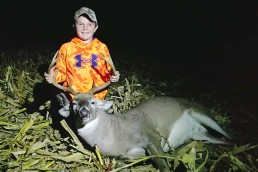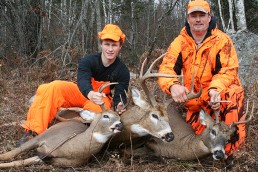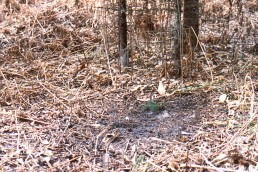Celebrating the Tall Tines of my First Trophy Buck
SHARE THIS POST
In November 2013, I harvested my largest buck to date—an 11-point, 152-inch deer in southeastern Kansas. Each year, this state ranks high in Pope & Young-record bucks. I had the opportunity to travel here the year before on a 1,500-acre tract of land farmed by a cattle rancher. That hunt included my good friend and mentor, Bill Burns, of Back to Life Taxidermy and Wildlife Art.
Bill is a fabulous taxidermist, and is really an artist who makes his mounts come back to life. The year before, Bill had bagged a nice 144-inch, 9-pointer.
But 2013 was my year.
I had my spot picked out in advance. Now in Kansas, at least in the area we were hunting, some of the best options are river bottoms. It was not uncommon for us to see three or four “140-plus” bucks each day and another five or six that were smaller.
I had put my tree steps up in two different trees: one in a river bottom and the other just off of the bottom on the east side of the valley. The bottoms offer cover for deer and provide a highway for the bucks to cruise up and down in search of their “sweethearts.”
As a tree-saddle hunter, you’re always on the lookout for trees that offer the best cover and are located next to the trails used by does and bucks. Unfortunately, the trees in this area are small and spindly. But one of the great advantages of hunting from a tree saddle is that you have many more options with trees than you would using traditional stands—the setup for your tree with the saddle offers minimal disturbance to the trunk and branches and gives you better mobility.
In the valley, and just off the bottom, the tree I chose was small. Once I completed my setup I was only about 14 feet off the ground, but the tree offered very good cover and provided me with six good shooting lanes. Since I could move to any side of the tree, I then had the opportunity to use three lanes behind me as well as my three lanes looking to the west.
The year before I had scouted this area we called the “Hidden Valley,” and decided when I came back that this was going to be one of my prime locations. This area is 1/2-mile-long-by-1/4-mile-wide, and was an open field boarded by a knoll on the south and west sides of the valley. There was a regular flow of deer that walked the knoll from the south to the north, in and out of the trees until they reached trees just to my west, about 100 yards on the north side of the valley.
I often saw them trot the knoll and stop to feed here—and in the case of the bucks, stop to observe the open valley to the east. The tree I was up was just off multiple trails, with four different intersections. There were also two scrapes about 30 yards away to my southwest. The deer were crossing the valley to my west and congregating in a small flat behind me just before it dropped off into the bottom. They also went by my location and would take a left heading north down a trail and toward the river.
I spotted him at the very south end of the valley, about 1/2-mile away, with his nose to the ground. Even at that distance I knew he was a shooter and the biggest deer I had ever seen. I slowly moved to the opposite side of the tree and watched him, using the tree as my cover for the next hour as he meandered in and out of the trees along the knoll.
I glassed him when the time was right.
Are you enjoying this post?
You can be among the first to get the latest info on where to go, what to use and how to use it!
Then, I realized that he was such a beautiful-looking buck, and definitely one neither of us had seen.
Once he reached the feeding area, he spent most of his time looking to the east across the valley. He was directly to my west, about 150 yards now.
For the next 30 minutes, I just watched him. The wind was coming out of the northeast so I wasn’t too worried about being busted; I just needed to sit tight and wait. I’m sure you all have been there—the heart is pounding and you’re just hoping that he will move close enough for an ethical shot.
He then started moving toward me at a pretty good clip. If he stayed on his current trajectory, I was going to get my shot. About halfway to me he stopped and so did my heart.
Did he see me? He was looking in my direction, but not at me.
A few minutes later he started again toward me. Then, after two more minutes, he was within range. He stopped about 25 yards from me, turned to the southwest and looked at the knoll and then offered up a perfect double-lung shot.
I took it and the rest is history.
He walked slowly away from me heading across the valley to a large cottonwood and lay down where I found him about 30 minutes later.He was the first trophy I ever bagged. Later, Bill made him “alive” again and he proudly hangs on my wall.
If you have any questions regarding the concept of tree saddle hunting, please contact Ian Munnoch at ianm@nuhunt.com or 812-322-5080.
MWO
SHARE THIS POST
Did you enjoy this post?
You can be among the first to get the latest info on where to go, what to use and how to use it!
Ian Munnoch
If you have any questions regarding the concept of tree saddle hunting, please contact Ian Munnoch at ianm@nuhunt.com or 812-322-5080.



